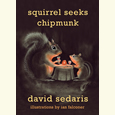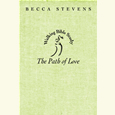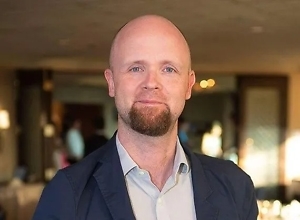Anxiety: A Coming-of-Age Story
With breadth, depth, and a healthy dose of doubt, Scott Stossel’s history of anxiety considers what it means to be human
Thomas Jefferson feared speaking in public. The repatriated Charles Darwin was an agoraphobe. Isaac Newton invented calculus but for ten years told no one out of fear of ridicule. Samuel Johnson was both hypochondriac and agoraphobic. Stage fright forced semi-retirement on Barbra Streisand, Carly Simon, Donny Osmond, and Hugh Grant. Anxiety has afflicted humankind from the beginning of time, according to Scott Stossel, author of My Age of Anxiety: Fear, Hope, Dread, and the Search for Peace of Mind. And it both inspires our best survival tactics and drives us into isolation and fear.
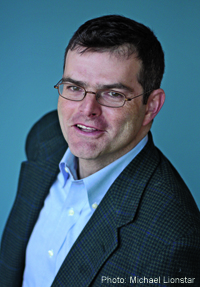 This nervous condition has been the source of some of history’s greatest ruminations on what it means to be human. In My Age of Anxiety Stossel, who is editor of The Atlantic, offers the latest intellectual and personal history of anxiety, reconsidering and expanding the musings of Hippocrates, Kierkegaard, Freud, and others. The story of his own anxiety—its appearance in childhood, its genetic influences, and the various treatments Stossel has undergone—offers a personal frame to the book’s discussion of the discovery of psychotropic drug therapy and the advancement of neuroscientific research.
This nervous condition has been the source of some of history’s greatest ruminations on what it means to be human. In My Age of Anxiety Stossel, who is editor of The Atlantic, offers the latest intellectual and personal history of anxiety, reconsidering and expanding the musings of Hippocrates, Kierkegaard, Freud, and others. The story of his own anxiety—its appearance in childhood, its genetic influences, and the various treatments Stossel has undergone—offers a personal frame to the book’s discussion of the discovery of psychotropic drug therapy and the advancement of neuroscientific research.
The historical, scientific, and deeply personal come together in My Age of Anxiety as Stossel offers a portrait of what is arguably the defining characteristic of our own age. He astutely observes the social implications of this diagnosis: anxiety may be the necessary side effect of a rapidly modernizing society, but at the same time it stigmatizes those who take fear (or let fear take them) too far.
While intellectual giants of the past may have shown symptoms of anxiety disorders but disguised them under high-functioning habits and successful careers (as Stossel himself has done), ultimately we still struggle to control anxiety and understand its origins. Is it a medical condition, as the ancient Greeks and contemporary neuroscientists would suggest? An intellectual problem to be reasoned away, as the philosophers of the Enlightenment believed? An urgent spiritual calling like that of St. Augustine, or a spiritual sickness like that which plagued the existentialists? The psychological side effect of sexual inhibition, as Freud suggested?
Stossel is meticulous in his examination of a condition that affects both physiology and personality, if not our very souls. He leaves little doubt that though anxiety has plagued every generation, now is the time for its coming of age. In advance of his appearance at the Southern Festival of Books, Stossel recently answered questions from Chapter 16 via email:
Chapter 16: Your book charts the rise of anxiety as a diagnosis that has grown—in patient numbers, definitive symptoms, and treatment plans—into a hallmark of humanity’s evolution. The depth of your research in the biological and social sciences and the nuance of your reporting are enough to define “the age of anxiety,” and yet you frame the book through memoir. Why expose yourself?
Scott Stossel: Good question—or at least that was a question I asked myself, and my therapist (“Dr. W” in the book), many times. And I was often tempted to extract myself from the book entirely. But Dr. W—as well as my agent and my editor—kept urging me to put more of myself into the book. I’d initially intended to put just a little of myself in the book, to kind of inflect the historical and scientific narrative and provide a humanizing case study (i.e., me) in order to make vivid some of the otherwise abstract historical ideas and scientific concepts I was talking about. But I certainly didn’t set out to write a memoir or to make myself the main subject of the book.
And what’s interesting is that, in the end, my own story is probably only about twenty-five-to-thirty percent of the book, at most—and yet that’s what most people seem to attach to. Yes, the book is called MY Age of Anxiety—but that was my agent’s idea. I originally wanted to call it The Anatomy of Anxiety, in homage to Robert Burton’s epic seventeenth-century book about depression and mental illness, The Anatomy of Melancholy. But my agent was clearly right. And despite my misgivings about, as it were, exposing or “outing” myself as anxious—misgivings that to some degree I still hold—after having hidden my anxiety from almost everyone for some thirty-five years or more, I published the book and the world didn’t end.
And for the most part, people—and especially anxiety sufferers—responded very positively and have said that the book had helped them, and in some cases even that the book transformed their lives. Exposing myself helped reduce by some iota the shame I feel about my anxiety—and, I would like to think, contributed in some modest way to the reduction of shame and stigma about mental illness generally. So that made me feel that the self-exposure was worthwhile. Also, as Dr. W. had suggested would be the case, I think my overall general level of anxiety may be mildly lower as a result of all of this—though I’m definitely not wholly cured or anything, and still struggle mightily at times.
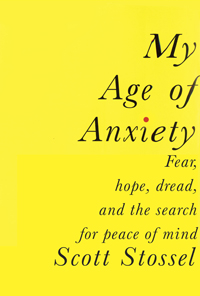 Chapter 16: Anxiety didn’t exist as a diagnostic category until thirty-five years ago. Is there any understanding of the human condition that we’ve lost through the evolution from melancholy to neurasthenia to hysteria to anxiety?
Chapter 16: Anxiety didn’t exist as a diagnostic category until thirty-five years ago. Is there any understanding of the human condition that we’ve lost through the evolution from melancholy to neurasthenia to hysteria to anxiety?
Stossel: For the most part, I think that the advances in the scientific understanding of anxiety, and the concomitant medicalization of anxiety as a disorder, have been a boon to people who suffer from it, for two main reasons. First, emerging neuroscientific research has yielded anti-anxiety medications and other treatments that can be effective for anxious sufferers, including myself: without the mid-century research done by Frank Berger and Leo Sternbach on Miltown and the early benzodiazepines, I would not have access to Xanax and Klonopin, without which I’m not sure I could have remained productively employed in some years. Second, transforming anxiety into a “medical disorder” with an organic basis as real as diabetes or Parkinson’s disease, as opposed to, say, psychological weakness or “craziness,” has to some degree helped to reduce stigma and allowed more people with debilitating anxiety to seek treatment.
On the other hand—and my views on this are admittedly complex and sometimes self-contradicting—I do think that carving up and bureaucratizing the diagnoses (panic disorder, generalized anxiety disorder, social anxiety disorder, OCD, etc.) has artificially segmented a spectrum of human temperament into discrete and somewhat arid compartments. I do believe that severe anxiety has a medical component—but also that it has a psychological component and a philosophical component and a cultural component and possibly a spiritual component. And some of that has been lost as we’ve gone from melancholy to neurasthenia to anxiety. (I’d exempt hysteria from this list: leaving that diagnosis behind has almost certainly been good for everyone, especially women.)
Chapter 16: You remember in vivid detail episodes of crippling anxiety when you were a child and suggest that your own children may have inherited anxious tendencies. What advice would you give parents of children with similar afflictions?
Stossel: I would say that if your children exhibit signs of what seem to be severe anxiety, seek guidance from a psychologist or medical professional. Lots of epidemiological evidence collected by researchers at Harvard suggests that getting help for kids early in the development of their anxiety can forestall its blooming into much more severe problems in adolescence and adulthood. We did this for our own phobic kids—and it worked wonders for our daughter, who is now eleven. (Our son, seven, is still a work in progress.)
Second, gently and lovingly push—even force—your kids to do the things that cause them anxiety, especially if those are normal activities like going to school, socializing with friends, going to sleepaway camp. Reams of evidence support the notion that (lovingly and supportively) forcing your kids to confront their anxiety is the best way to help them overcome it. But I can say from firsthand experience, both as a miserable, terrified kid and as an anxious father, that this is much easier said than done: my natural instinct with my own kids is to shield them from anything that causes them anxiety, and to coddle and overprotect them—to spare them from all distress always. But the research says that’s almost always more damaging than it is helpful. Fortunately, my wife is much steelier than I am about getting our kids to do things that initially scare them—because nine times out of ten they come away from the experience feeling less scared and more competent at dealing with what the world throws their way.
Chapter 16: Symptoms of anxiety have been associated with cowardice (in soldiers and athletes), malaise and frustration (particularly in women at home) on the one hand, and with great ambition and upward mobility (elite men in industrialized countries) on the other. What strikes you most about the polarity between stigmatization and privilege in this nervous condition?
Stossel: You’ve identified a phenomenon that extends back millennia: the simultaneous valorization of the mad creative genius and stigmatization of the weak, crazy person. During the Renaissance, melancholy was believed to be associated with creativity; at times during British history, a nervous temperament was thought to be a sign of refinement and good breeding; and in the United States being a “neurasthenic,” or being overstressed as we might say today, was seen as a sign of being an important and hardworking person.
But more often stigmatization has prevailed, especially when the anxiety is clearly clinical or pathological. In my book, I do try to look for redemptive qualities in anxiety, and there actually is a good amount of evidence that various forms of creativity and genius can be associated in some way with mental illness. But I think that sometimes gets overstated—and it’s certainly not the case that simply being anxious will make you smarter and more creative. I think we’d probably be better off if both the stigma and the privilege were diminished. (And stigma is certainly the greater problem.)
Chapter 16: “Once you create a new disease, it starts to take on a life of its own,” you note in studying the aftermath of the decision to include “generalized anxiety disorder” in the DSM. For some this new knowledge is life-giving, but how does it fuel a culture that capitalizes on the “pathology of everyday behaviors?”
Stossel: As I say, the medicalization of psychiatry and of mental illness is on balance a good thing. But in some ways it’s already gone too far: every human trait (say, irritability) or temperamental disposition (say, shyness) gets turned into a disease category. And the pharmaceutical companies have an incentive to exploit this, to expand the number of psychiatric diseases and enlarge the definitions of the disorders because that increases the size of the market for their drugs. The line between, say, “normal” anxiety and clinical anxiety is not always so easy to draw: what’s the distinction between what used to be called the “worried well” and the mentally disordered?
So I think in some ways that, as a society, we’re both overdiagnosed and underdiagnosed, and therefore both overmedicated and undermedicated. What I mean by this is that there are plenty of people who—because of the profit imperatives of the drug companies and the incentives of the insurance companies and psychiatrists (who are paid as much for a fifteen-minute psychopharmacology consult as they are for a fifty-minute psychotherapeutic session) —end up taking drugs they don’t really need; at the same time, there are plenty of people, especially in underserved communities, who are truly suffering with real clinical disorders yet either don’t know how to get help or resist seeking help and getting the medication they need because of fears they’ll be stigmatized, labeled as weak or crazy.
Chapter 16: As editor of The Atlantic, you publish articles with a similar combination of personal narrative and expository writing. What advice would you give to a writer seeking the right balance of genres for this kind of book or article?
Stossel: I find it hard to give good general advice about this because each book or article will, depending on the topic and the voice of the author and the intended audience, have its own ideal mix of narrative and expository or explanatory writing. As a rule, we find that readers gravitate both to good storytelling and to strong arguments—and that, in this age of social media, where so many people discover our articles via Facebook or Twitter, readers are especially drawn to stories they can relate to in some personal way or that speak to their own lives. One thing I always try to keep in mind, both when I’m writing my own stuff and editing other authors’, is: don’t bore your readers. Keep them moving along with narrative pacing, or fascinating facts or insights, or, when necessary, bits of writerly brio—so you’re giving them the proverbial spoonful of sugar to help the medicine go down. (And you’ll never please everyone: some readers thought my book got bogged down by all the expository and scientific writing and said they’d wished the book were purely personal narrative; others wanted only the expository parts and found the personal stuff distracting or self-indulgent.)
Chapter 16: You end on an uncertain but hopeful note that writing about your anxiety will somehow heal you or at least prove to be more useful to others and less shameful to you. Now that the book has been out for eight months and you’ve made many public appearances in support of it, how did this experiment turn out?
Stossel: The jury is still out. But early signs are mostly auspicious.
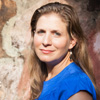
Beth Waltemath graduated with a degree in English from the University of Virginia and worked at both Random House and Hearst magazines before leaving publishing to attend Union Theological Seminary in New York City. A Nashville native, she now lives in Decatur, Georgia.

